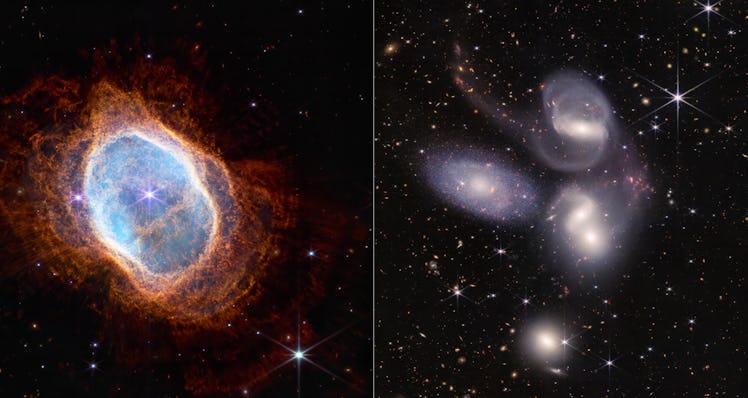7 Amazing Things To Know About The Spectacular Webb Telescope Photos
NASA released several photos taken from the James Webb Space Telescope that show the far reaches of outer space in detail we’ve never seen before.

Straight up: Space is cool. There is so much about it that we don't know and have yet to discover. Luckily, the good scientists at NASA are passionate about finding out what they can about the vast world outside our orbit. And as advancements in technology make the exploration of worlds, galaxies, and black holes beyond our own more possible, we Earthlings get to enjoy the view. Just today, NASA released incredible information and photographs after its James Webb Space Telescope (JWST) captured photos of the universe, deeper than we've ever seen before.
President Joe Biden shared a photo on Monday, July 11, that the telescope captured of a galaxy cluster. The image is striking, to be sure, but it’s way cooler — like way cooler — than it looks at first glance when you learn more about it.
On July 12, NASA released several other photos from the JWST that show space in detail, as we've never seen before. Here are some incredible things you need to know about the James Webb Telescope photos as we continue to learn more information about the world beyond our own. (And, while you’re at it, read this article about why many want to rename the JWST.)
1. What we can see in this photo is a tiny slice of the universe.
According to CNN, this image shows gravity cluster SMACS 0723, of which the mass of the galaxy clusters acts like a magnifying glass. Besides this image being the clearest ever image taken of the universe, it also means that what we see in the photo is far smaller than it appears.
"This slice of the vast universe covers a patch of sky approximately the size of a grain of sand held at arm's length by someone on the ground," the space agency wrote in an image description of the photo.
"You're seeing galaxies that are shining around other galaxies whose light has been bent, and you're seeing just a small, little portion of universe," NASA Administrator Bill Nelson said. Absolutely mind-bending.
2. The galaxies in this photo are old and probably gone.
In the photo of the SMACS 0723 group of galaxy clusters, the star clusters and galaxies we see are probably long dead. The snapshot in time captured in the photo was what it looked like 4.6 billion years ago.
"Light from these galaxies took billions of years to reach us," NASA explains in an article on the new image. "We are looking back in time to within a billion years after the big bang when viewing the youngest galaxies in this field. The light was stretched by the expansion of the universe to infrared wavelengths that Webb was designed to observe."
3. The multi-color dots we see aren't stars.
The images we've seen are pretty, bright, and full of color and astounding detail. They’re clearer than anything we’ve ever seen. But the really cool thing about this tiny blip of space is that each of those colored dots or specks are not stars — they're entire galaxies. Yes, each one.
4. The JWST is way stronger than the Hubble telescope.
Last view of the James Webb Space Telescope
Before JWST, there was the Hubble telescope, which was also pivotal for space exploration. The Hubble telescope advanced the discovery of the universe and paved the way for the images that were just released. But with the JWST, researchers can capture pictures much faster. These images were taken over 12.5 hours — for the Hubble to do the same, it would require weeks of time.
5. There are photos of what a "dying star" looks like. And it's beautiful.
"Two cameras aboard Webb captured the latest image of this planetary nebula, cataloged as NGC 3132, and known informally as the Southern Ring Nebula," NASA explains. “It is approximately 2,500 light-years away."
This view lets researchers see, in full view, the second star of the nebula. The images also captured the dust and gas around the stars. It's not only incredibly stunning but will also give researchers a lot of information they can use to start to piece together more details of our universe and how life came to be.
6. The images show more of Stephan's Quintet, which was discovered in 1877.
Stephan's Quintet, a grouping of five galaxies, was discovered by French astronomer Édouard Stephan back in the late 1800s. Stephen’s Quintet was the first group of galaxies found, so the astounding display has been in the know for hundreds of years, but the JWST captured a view of the quintet galaxies like we've never seen before.
"Sparkling clusters of millions of young stars and starburst regions of fresh star birth grace the image," NASA writes. "Sweeping tails of gas, dust, and stars are being pulled from several of the galaxies due to gravitational interactions. Most dramatically, Webb captures huge shock waves as one of the galaxies, NGC 7318B, smashes through the cluster."
7. The images are really big, with the one capturing Stephan's Quintet being the largest.
We know these images show a small speck of space, but the images NASA was able to get from JWST are actually really large. "This enormous mosaic is Webb's largest image to date, covering about one-fifth of the Moon's diameter," NASA explains.
"It contains over 150 million pixels and is constructed from almost 1,000 separate image files. The information from Webb provides new insights into how galactic interactions may have driven galaxy evolution in the early universe."
Really stunning stuff.
This article was originally published on